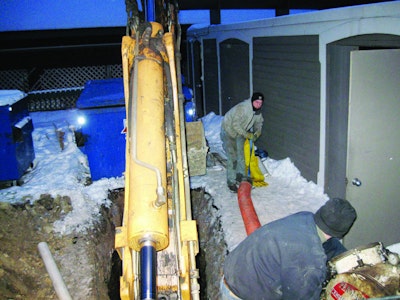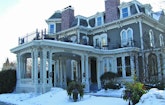
Interested in Cleaning?
Get Cleaning articles, news and videos right in your inbox! Sign up now.
Cleaning + Get AlertsThe mechanical contractor for Forepaugh’s Restaurant hired a plumber to clean the drains, but the attempts only enabled the restaurant to limp along until the next episode. The contractor then called Grant Utilities, a local water and sewer utility contractor specializing in cured-in-place pipe rehabilitations.
Grant Utilities’ owner Grant Engen used a MyTana camera system to inspect the 4-inch cast iron lateral from a kitchen cleanout. At 11 feet, the camera revealed the problem. “The joint had failed where the lateral connected to the 6-inch clay tile sewer,” he says. “Wastewater hitting the debris backed straight into the kitchen.”
Although 12 feet of rocky soil separated the joint from the enormous heating, ventilation, and air conditioning units above it, Engen speculated that vibrations from the machinery sifted material into the opening. The only feasible, economical solution was lining the lateral.
“We measured the distance to the joint three times with the camera,” says Engen. “The short distance made calculations easier, but accuracy was still key. If we messed up, we were out of options, as there was no way to open-cut the line.”
Working mostly at night in sub-zero temperatures and wind chills, Engen and three technicians repaired the joint with a transition liner from Perma-Liner Industries, enabling patrons to again enjoy refined culinary dining experiences.
Preparing the way
During the week, Forepaugh’s opened at 5 p.m. Engen staged his equipment near the restaurant’s trash receptacles and HVAC enclosure. “Our plan was to access the lateral as it left the enclosure, then clean upstream,” he says.
After breakers on the Case 590 Super M excavator bucket broke through the 42 inches of frozen ground, operator Mike Boston dug an 8- by 10- by 12-foot-deep pit and lowered a metal trench box. The unstable bottom of the pit made it necessary for Boston to suspend the box by chains. Workers then exposed the line and Brandon Hedlund made a dry run with the inversion unit to guarantee that the delivery hose lined up with the host pipe.
“We couldn’t jet the line until after the restaurant staff finished cleaning up for the night,” says Engen. The crew returned at 11 p.m. with a portable MyTana jetter delivering 3,200 psi/12 gpm and a 32-foot heated trailer with Perma-Liner equipment. “We custom-built the trailer because we needed more room to work,” says Engen.
To illuminate the area, they used the lights on the excavator, mounted a light to the arm so it shined into the trench box, and lowered a trouble light into the hole. A generator mounted next to the trailer supplied power.
Upon opening the lateral, Hedlund found the pipe in good shape after its two recent cleanings. He touched it up using a standard jetting nozzle. Meanwhile, Stan Odger covered the kitchen floor with tarps to protect it from the snow and dirt on their boots, while Engen taped down the floor and sink drains to prevent the traps from spitting water when air was introduced into the pipe.
“With the drains sealed, air vents out the stack instead of making a mess,” says Engen. “We tried to minimize the time the staff would have to spend sanitizing the kitchen after we left.”
Baby, it’s cold outside!
Inside the trailer, the team measured and cut the 20-foot-long 3-mil transition liner with 4- and 6-inch lengths sewn together. Because Perma-Liner doesn’t have a resin applicable for sub-zero temperatures, Engen chose the closest match: the company’s cold weather resin with chemical reaction beginning at 137 degrees F.
“Cold weather stresses everything,” says Engen. “When resins are shocked by the introduction of minus 2 degree air, it takes time for the chemicals to recover. Our biggest concern, however, was condensation developing in the air compressor, then freezing in the hoses.”
Before wetting out the liner, they started the compressor, blew it out, and kept it running to prevent moisture buildup. “That way, when we hook the hoses to the inversion unit, we’re getting a full flow of air,” says Engen.
After wetting out the liner and lubricating it with vegetable oil, the crew rolled it inside the inversion machine. “We work inside the trailer as long as possible to keep everything warm,” says Engen. “I wasn’t worried about shortening working time because it was so cold outside.”
After stationing the air hoses by the hole, the crew rolled the inversion unit down the trailer ramp and wrestled it to the pit. Because of its depth, Hedlund tilted the unit downward, enabling Boston to line up the hose and pipe in the hole. They inverted the liner at 9 psi, stopping 6 inches short of the cleanouts.
Despite the cold, the yellow calibration tube rolled easily into the inverter, then inflated at 10 psi. The pressure was maintained while the resins cured. “Everything done outdoors in winter takes twice as much time as in summer, because the guys are wearing bulky clothes and can’t move as fast,” says Engen. “They also were unaccustomed to working off hours and at night.”
Better safe than sorry
Over the seven hours the liner remained inflated, the team took turns going into the pit to monitor the gauges and make sure everything was holding pressure. “Although the liner can feel firm where it is exposed, I don’t know what’s happening with the rest of it,” says Engen. “I erred on the side of caution and always cure liners longer than the manufacturer’s recommended time.”
In the morning, they removed the calibration tube and connected the liner to the sewer with a length of PVC pipe and Fernco rubber couplings. To fulfill the city’s requirement for a post-inspection DVD, Hedlund inspected the liner from the kitchen where the cold could not affect the electronics. “It was a good effort,” says Engen. “We got them up and running without any further issues.”







